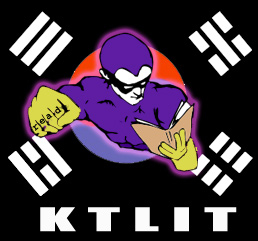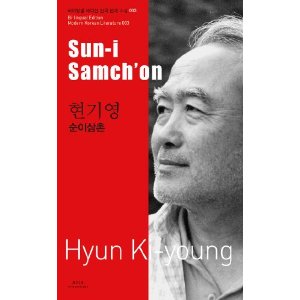 Looking out at various things in the Korean translatosphere, it seems that good-hearted efforts are being undermined by poor planning, and the latest example of this can be found in the 15 volume collection of novellas just published by Asia Publishers.
Looking out at various things in the Korean translatosphere, it seems that good-hearted efforts are being undermined by poor planning, and the latest example of this can be found in the 15 volume collection of novellas just published by Asia Publishers.
It sounds like a good project when you read the explanation:
Asia Publishers present some of the very best modern Korean literature to readers worldwide through its new Korean literature series “Bi-lingual Edition Modern Korean Literature”. We are proud and happy to offer it in the most authoritative translation by renowned translators of Korea literature. We hope that this series helps to build solid bridges between citizens of the world and Koreans through rich in-depth understanding of Korea.
Unfortunately one quick look at the books, and how they are being publicized, puts complete ‘paid’ to the idea that any bridges will be built. First we will look at the books as an entire project, and then at the books as single entities.
The first problem is that all of this effort has been expended on works that have already been translated. Take a quick look at the complete list, keeping in mind the following coding:
Previously translated as novella.
Excerpt of a previously published entire work
Previously translated in a collection
Previously untranslated
- The Wounded (Bi-lingual Edition Modern Korean Literature, Volume 1) by Yi Cheong-jun (2012)
- Soul of Darkness (Bi-lingual Edition Modern Korean Literature, Volume 2) by Kim Won-il
- Sun-i Samch’on (Bi-lingual Edition Modern Korean Literature, Volume 3) by Hyun Ki-young
- Mother’s Stake I (Bi-lingual Edition Modern Korean Literature, Volume 4) by Pak Wan-so
- The Land of the Banished (Bi-lingual Edition Modern Korean Literature., Volume 5) by Jo Jung-rae
- Record of a Journey to Mujin (Bi-lingual Edition Modern Korean Literature., Volume 6) by Hwang Sok-yong
- The Road to Sampo (Bi-lingual Edition Modern Korean Literature., Volume 7) by Hwang Sok-yong
- The Man Who Was Left as Nine Pairs of Shoes (Bi-lingual Edition Modern Korean Literature., Volume 8) by Yun Heung-gil
Our Friend’s Homecoming (Bi-lingual Edition Modern Korean Literature (15 Volumes Set), Volume 9) by Shin Sang-ung - The Poet of W?nmi-dong (Bi-lingual Edition Modern Korean Literature., Volume 10)
- Chinatown (Bi-lingual Edition Modern Korean Literature., Volume 11) by Oh Jung-hee
- The Place Where the Harmonium Was (Bi-lingual Edition Modern Korean Literature., Volume 12) by Shin Kyung-sook
- The Last of Hanak’o (Bi-lingual Edition Modern Korean Literature., Volume 13) by Ch’oe Yun
- Human Decency (Bi-lingual Edition Modern Korean Literature., Volume 14) by Gong Jiyoung
- Poor Man’s Wife (Bi-lingual Edition Modern Korean Literature., Volume 15)
So, in the entire collection there are four new works (and my knowledge is far less than encyclopedic, some of these works may well have been published and I am just unaware of them).
Thus, the collection is flawed as an entirety. Other problems quickly become apparent. If you search for one of the books on Amazon you are not presented with a common publishers link or a common link related to the collection!! This means that even if you find one of the books, you will find no way to connect to any of the other ones. The main advantage of the web, of being listed on Amazon, is intertextuality and this collection has punted that into another galaxy.
Then there is the issue of the Romanization. Translators and other old-fashioned folks^^ immoderately love McCune-Reischauer Romanization with its typographic collection of tics, glyphs (technically known as breves) and glyphs (technically known as random spacing^^). But this Romanization system is nearly impossible for the casual reader to work out, so it both makes reading slower and makes character identification more difficult. In addition, it also does not always display well on the Internet:
Then there’s the bilinguality – I’m not against it, I just don’t think it’s generally useful. The number of folks who will dip into both languages is likely to be far greater on the Korean-language side than the English-language side, on which only eager learners like myself will look and/or professors and students who already are interested in Korean language, literature and culture. In other words, this the worst kind of preaching to the choir.
Decisions made on the individual books also bear the mark of no marketing thought. I’ll take
Paul Buckley, the Vice President Executive Creative Director at Penguin Group USA says,
“he cover may very well be the single biggest piece of marketing that book will receive. For first time authors and writers that have not yet built up a big following, the cover may be the only thing that gets a reader (or reviewer, for that matter) to physically pick the book up.
Then, if a browser does pick a book up (and we’ve already lost many of them on that first decision):
Bookstore browsers spend an average of 8 seconds looking at the front cover and 15 seconds studying the back cover before making a buying decision where your book goes straight to the cash register, not back on the shelf.
Online bookstores such as Amazon reduce the decision time even further. In mere seconds, your cover sings or is ignored among the other small thumbnail covers in the search genre.
<http://www.amarketingexpert.com/8-mistakes-that-will-absolutely-kill-your-book/>
So, how do the bookcovers in this series do?
Really poorly. Red is a good color, because it catches the eye, but after that, the covers here are worse than pedestrian. They don’t reflect anything about the stories inside (a really terrible choice for Sun-i Samch’on, whose title reflects NO meaning in English, and a confused one – depending on an extremely vernacular Jeju usage of ‘uncle’ to mean ‘aunt’ – in Korean). In fact, instead they have photographs of the authors. This practically screams, ‘uninteresting academic blather.’
This is just a marketing fail.
Finally (and only with respect to Sun-i Samch’on/Aunt Suni), a story I heard is that it is a re-edit of the original non-sensical translation from two years ago. That would have to be an improvement, but given the flaws of the original translation, certainly this work, even among the others, should have had a complete re-translation?
On Amazon it is impossible to see if the translators are even credited, so until I get my hands on these books, I’ll have to hold off final judgment on that.
Still, I’m sure that quite a few well-intentioned people got together on this project, and I’m certain that substantial money was spent on it. And as it stands it will not make the slightest impact on the market.
Korea-savvy readers, the few-hundred (guessing from book sales of less popular titles like Who Ate Up All the Shinga) will certainly buy these.
But no one else will.
Finally, two sets of numbers from Amazon to make you consider where resources should be going…
A direct comparison:
Today the new Asia Publishers version of Last of Hanako – UNRANKED!
Today THE PREVIOUS version of Last of Hanako – Amazon Best Sellers Rank: #3,099,280
An indirect comparison
Today Sun-i Samch’on Amazon Best Sellers Rank: #2,010,501
Last Thursday Black Flower Amazon Best Sellers Rank: #96,304




